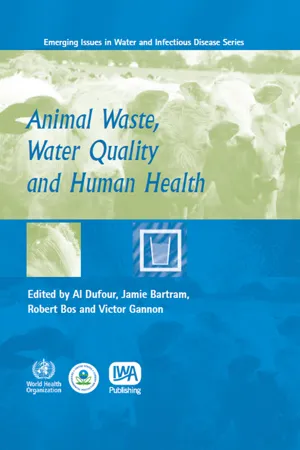
- 488 pages
- English
- PDF
- Available on iOS & Android
eBook - PDF
Animal Waste, Water Quality and Human Health
About this book
Domestic animals contaminate recreational waters and drinking-water sources with excreta and pathogens; but this threat to public health is inadequately understood and is insufficiently addressed in regulations. More than 85% of the world's faecal wastes is from domestic animals such as poultry, cattle, sheep and pigs. These animals harbor zoonotic pathogens that are transported in the environment by water, especially runoff. However little information exists on health effects associated with exposure to this potential hazard to human health; and water standards focused on control of human fecal contamination do reflect the contribution of non-human fecal contamination to risk. Does compliance with current monitoring practices using microbial indicators provide protection against animal and bird sources of fecal contamination?
Prepared with contributions from a group of international experts, Animal Waste, Water Quality and Human Health considers microbial contamination from domestic animal and bird sources and explores the health hazards associated with this microbial contamination and approaches to protecting public health. Animal Waste, Water Quality and Human Health will be of interest to regulators with responsibility for recreational waters, drinking water quality and water reuse; policymakers working in water quality, public health and agriculture; decision makers responsible for livestock management; and scientists and practitioners concerned with many affected subjects.
Topics covered include:
- Credible waterborne zoonotic pathogens are discussed and ranked according to their potential hazard level. Each pathogen is described with regard to their sources, reservoirs, and infectivity.
- Faecal production rates of various domestic animals are discussed, alongside pathogen transmission in animal populations, pathogen prevalence in animals and "supershedders".
- Transport of fecal indicator organisms and their episodic occurrence in catchments.
- Interventions for improving food safety and reducing production losses.
- The impact of interventions, e.g. enhanced attenuation and storage to prevent spills; benchmarking against best management practices to reduce diffuse source contamination.
- Models to inform design of farm-scale best management practices and the effectiveness of best management practices for attenuating pathogen transport within catchments.
- The complex nature of human exposure to zoonotic waterborne pathogens; including the relationships among livestock waste contamination, water impairment, zoonotic pathogens, and human infection and illness.
- Human exposure interventions include case studies that discuss eradicating disease in discharging populations, adding filtration to minimal treated water to reduce Cryptosporidium occurrence and UV disinfection of beach waters to reduce beach postings.
- Indicators, sanitary surveys and source attribution techniques; risk assessment of exposure to zoonotic pathogens, including an interactive risk comparison approach.
- A review of epidemiological studies that address the relationship between swimmer illness and exposure to waters contaminated by nonhuman fecal wastes.
- Economic evaluation of the costs and benefits associated with animal waste management and human health.
Frequently asked questions
Yes, you can cancel anytime from the Subscription tab in your account settings on the Perlego website. Your subscription will stay active until the end of your current billing period. Learn how to cancel your subscription.
No, books cannot be downloaded as external files, such as PDFs, for use outside of Perlego. However, you can download books within the Perlego app for offline reading on mobile or tablet. Learn more here.
Perlego offers two plans: Essential and Complete
- Essential is ideal for learners and professionals who enjoy exploring a wide range of subjects. Access the Essential Library with 800,000+ trusted titles and best-sellers across business, personal growth, and the humanities. Includes unlimited reading time and Standard Read Aloud voice.
- Complete: Perfect for advanced learners and researchers needing full, unrestricted access. Unlock 1.4M+ books across hundreds of subjects, including academic and specialized titles. The Complete Plan also includes advanced features like Premium Read Aloud and Research Assistant.
We are an online textbook subscription service, where you can get access to an entire online library for less than the price of a single book per month. With over 1 million books across 1000+ topics, we’ve got you covered! Learn more here.
Look out for the read-aloud symbol on your next book to see if you can listen to it. The read-aloud tool reads text aloud for you, highlighting the text as it is being read. You can pause it, speed it up and slow it down. Learn more here.
Yes! You can use the Perlego app on both iOS or Android devices to read anytime, anywhere — even offline. Perfect for commutes or when you’re on the go.
Please note we cannot support devices running on iOS 13 and Android 7 or earlier. Learn more about using the app.
Please note we cannot support devices running on iOS 13 and Android 7 or earlier. Learn more about using the app.
Yes, you can access Animal Waste, Water Quality and Human Health by A. Dufour,Jamie Bartram in PDF and/or ePUB format, as well as other popular books in Technology & Engineering & Environmental Science. We have over one million books available in our catalogue for you to explore.
Information
Table of contents
- Cover
- Contents
- Summary Statement1
- 1: Introduction
- 2: Assessing the importance of zoonotic waterborne pathogens
- 3: Zoonotic waterborne pathogen loads in livestock
- 4: Zoonotic waterborne pathogens in livestock and their excreta – interventions
- 5: Transport of microbial pollution in catchment systems
- 6: Effectiveness of best management practices for attenuating the transport of livestock-derived pathogens within catchments
- 7: Exposure
- 8: Exposure interventions
- 9: Indicators, sanitary surveys and source attribution techniques
- 10: Comparative risk analysis
- 11: Epidemiological studies on swimmer health effects associated with potential exposure to zoonotic pathogens in bathing beach water – a review
- 12: Economic evaluation
- Index